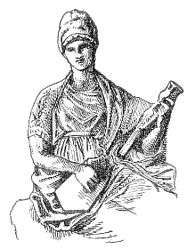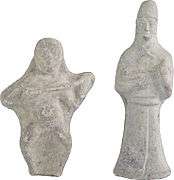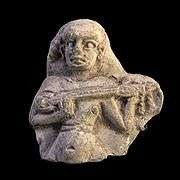Pandura
|
Modern lithograph of a bas relief from Mantineia (4th century BC), exhibited at National Archaeological Museum of Athens. The image shows a muse playing a pandoura, and the original is the oldest image of a pandoura currently known. | |
| Classification |
|
|---|---|
| Related instruments | |
The pandura (Ancient Greek: πανδοῦρα, pandoura) was an ancient Greek string instrument belonging in the broad class of the lute and guitar instruments. Musical instruments of this class have been observed in ancient Greek artwork from the 3rd or 4th century BC onward.[1]
Ancient Mesopotamian predecessors
Lute-class instruments were present in Mesopotamia since the Akkadian era, or the third millennium BCE.[2]
| Mesopotamian examples | ||||
|---|---|---|---|---|
|
Greek

The ancient Greek pandoura was a medium or long-necked lute with a small resonating chamber, used by the ancient Greeks. It commonly had three strings: such an instrument was also known as the trichordon (τρίχορδον, McKinnon 1984:10). Its descendants still survive as the Greek tambouras and bouzouki,[3][4] the North African kuitra, the Eastern Mediterranean saz and the Balkan tamburica and remained popular also in the near east and eastern Europe, too, usually acquiring a third string in the course of time,[5] since the fourth century BCE.
Renato Meucci (1996) suggests that the some Italian Renaissance descendants of Pandura type were called chitarra italiana, mandore or mandola.
Roman


Information about Roman pandura-type instruments comes mainly from ancient Roman artwork. Under the Romans the pandura was modified: the long neck was preserved but was made wider to take four strings, and the body was either oval or slightly broader at the base, but without the inward curves of the pear-shaped instruments.[10] The word pandura was rare in classical Latin writers.[11]
Eastern variations
There were at least two distinct varieties of pandura.[10] One type was pear-shaped, used in Assyria and Persia.[10] In this type the body had graceful inward curves which led up gradually from base to neck.[10] These curves changed at the bottom end off the instrument to a more sloping outline, an elongated triangle with the corners rounded off.[10] The oval type, a favourite instrument of the Egyptians, was also found in ancient Persia and among the Arabs of North Africa.[10]
Caucasus
From the ancient Greek word pandoura, a comparable instrument is found in modern Chechnya and Ingushetia, where it is known as phondar. In Georgia the panduri is a three-string fretted instrument. The modern Georganian panduri instrument is in the tanbur class.
See also
Notes
- ↑ Alexander Lingas, "Musical instruments" in Encycolpedy of Ancient Greece p 385.
- ↑ Scheherezade Qassim Hassan; Morris, R. Conway; Baily, John; During, Jean (2001). Sadie, Stanley; Tyrrell, John, eds. The New Grove Dictionary of Music and Musicians. xxv (2 ed.). London: Macmillan. pp. 61–62.
- ↑ instruments-museum, Greece
- ↑ Elizabeth Jeffreys, John Haldon, Robin Cormack, The Oxford Handbook of Byzantine Studies, Oxford University Press, 2008, p.928; confer also Nikos Maliaras, Byzantina mousika organa, EPN 1023, ISΒN 978-960-7554-44-4 and Digenis Akritas, Escorial version, vv. 826-827, ed. and transl. Elizabeth Jeffrey.
- ↑ The Facts on File Dictionary of Music, Fourth edition
- ↑ The sarcophagus is at The British Museum: REF. The British Museum says it was uncovered near Rome and was probably made in Rome itself, and date-estimates it 3rd century AD.
- ↑ https://m.flickr.com/#/photos/julio-claudians/8098646683/ Flicker based photo of the museum information sign for the stele.
- ↑ Jonathan Edmondson, Trinidad Nogales, Walter Trillmich, Imagen y memoria: monumentos, funarios, con retratos en la colonia Augusta
- ↑ [http://ceres.mcu.es/pages/ResultSearch?Museo=MNAR&txtSimpleSearch=Estela%20de%20Lutatia%20Lupata&simpleSearch=0&hipertextSearch=1&search=simple&MuseumsSearch=MNAR|&MuseumsRolSearch=26&listaMuseos=[Museo%20Nacional%20de%20Arte%20Romano] Museo Nacional de Arte Romano, Merida, Spain, online page for Lutatia Lupatia stella.]
- 1 2 3 4 5 6 "Pandura" in Encyclopedia Britannica, year 1911.
- ↑ Search for word pandura at Latin.PackHum.org, a website that is able to boast: "This website contains essentially all Latin literary texts written before A.D. 200, as well as some texts selected from later antiquity." Pandura is very rare as a word in classical Latin texts, but pandura-type instruments are not very rare in ancient Roman artwork. This raises the question: what then did the ancient Romans call it? Classical Latin cithara meant a lyre-type instrument at least sometimes, but sometimes it meant any plucked string musical instrument, and it seems very probable that the pandura was called by the name cithara in classical Latin at least sometimes. The classical Latin dictionary of Lewis and Short translates Classical Latin cithara as English "cithara, cithern, guitar, or lute" – cithara @ Lewis & Short.
References
- J.W. McKinnon "Pandoura" in New Grove Dictionary of Musical Instruments Vol 3 p 10 ed S. Sadie (Macmillan Press, London 1984).
External links
| Wikisource has the text of the 1911 Encyclopædia Britannica article Pandura. |
- Picture of a pandura, originally published 1947 in the book The Great Palace of the Byzantine Emperors by David Talbot Rice. Henry George Farmer calls the instrument "a three-stringed pandoura" in his 1949 article An Early Greek Pandore.
- Website that has a history of Pandura with some good photos.


